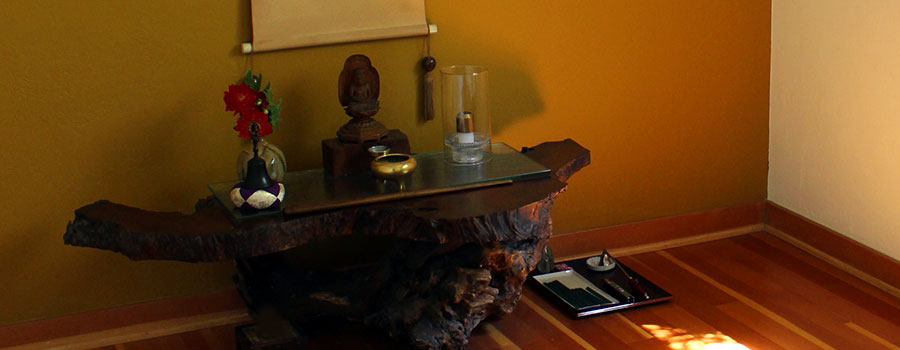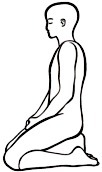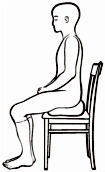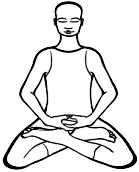
How to Sit in Zazen
Posture
There are five basic sitting positions from which to choose: the full lotus, the half-lotus, the Burmese, and seiza, or kneeling. You may also use a chair. The essential point is to find a position which you can maintain. Most of us can tolerate some minor discomfort, but if a particular position is unduly painful, find another one that isn’t. Weight, flexibility, and body type all influence your experience of sitting, so be mindful of your body.

In the Full Lotus position, the right foot rests on the left thigh and the left foot rests on the right thigh. In Half-Lotus, the left foot rests on the right thigh, while the right leg is folded under the left leg.

In Burmese position, both legs are folded, resting on the square mat (zabuton). One variation of this position places the left foot upon the right calf.

In seiza or kneeling position, knees are shoulder-width apart while buttocks are supported either by the heels, a zafu (sitting cushion) or other cushion, or a low sitting bench.

Using a chair, avoid slouching but sit upright. If you have back trouble, a firm cushion can be used to support your lower back. Keep your feet shoulder-width apart on the floor. If the chair is too high for you, place a zafu on the floor to support your feet. Make sure your hips are higher than your knees.
In each of these positions: Seat yourself on the forward third of your cushion (or chair), using an extra cushion if needed, so that your hips are slightly higher than your knees. Tuck in your chin slightly and make sure your nose is aligned with your navel and your ears aligned with your shoulders. Your head should rest squarely over your spine and not tilt or lean in any direction. If you notice any tension in your shoulders, relax them. Slightly arching the small of the back so that the pelvis tilts forward, extend your spine upward. Avoid straining or tensing either your back or abdominal muscles. To center your body, sway several times from the hips in decreasing arcs until you drift to a stop. In this position, your posture is upright, leaning neither left nor right, forward nor backward.

Place your left hand, palm up, on the palm of your right hand. Rest your hands in your lap. Keep your eyes slightly open, looking downward in the direction of the floor a few feet in front of you. Let them drift out of focus. If facing a wall, look downward at about a 45-degree angle, and let your eyes drift out of focus.
Breathing
Take a few deep slow breaths through the mouth, and exhale freely, to settle mind and body. Close your lips and swallow any saliva in your mouth. Empty your mouth of air, creating a slight vacuum. Avoid tensing your jaws. Breathe quietly through your nose. Place the tip of your tongue on the roof of your mouth just behind the front teeth. Let your breathing become deep and natural, without particularly straining to control it.
Attention
Pay close attention to your breathing, to the sensations of breath leaving and entering your body with each exhalation and inhalation. Be aware of the movement of your lower abdomen. As you inhale, notice it expand; as you exhale, notice it contracting. Direct your attention to the center of your lower abdomen, about two or three inches below the navel, or onto the palm of your left hand. As you breathe, you may count each breath, repeating the process and counting each exhale/inhale cycle as one breath. When you have counted ten breaths, return to “one,” and begin again. Do this until you can focus your attention and maintain it. Once you are able to count your breaths, you may be ready to follow your breaths without counting. Simply follow your breathing attentively. When you notice your mind wandering or pursuing thoughts, memories, emotions, etc., simply notice this and return your attention to your breath in the present moment.

Let your attention remain with your breath. Be patient with yourself, as it may take some time before you can reliably focus your attention for an extended period of time. At first, you may only sit a few times a week, for a few minutes. At your own pace, gradually increase the frequency and duration of your sitting until you can sit daily for 30 to 35 minutes at a time. Don’t rush this process, but allow your mind and body to gradually adjust to the practice. Some people prefer to sit in the morning, others at night, and some do both. Experiment to find which of these works best for you, then make it your own regular practice. When practicing, it is useful to sit in the same place and at the same time of day, if possible.
Patience, consistency, and perseverance are important in establishing and settling into your practice. We strongly recommend regular sitting at a Zen center or with a similar sitting group, if you have access to one, and to work with a qualified Zen teacher.
Illustrations from Zen Meditation In Plain English by John Daishin Buksbazen, Wisdom Publications
